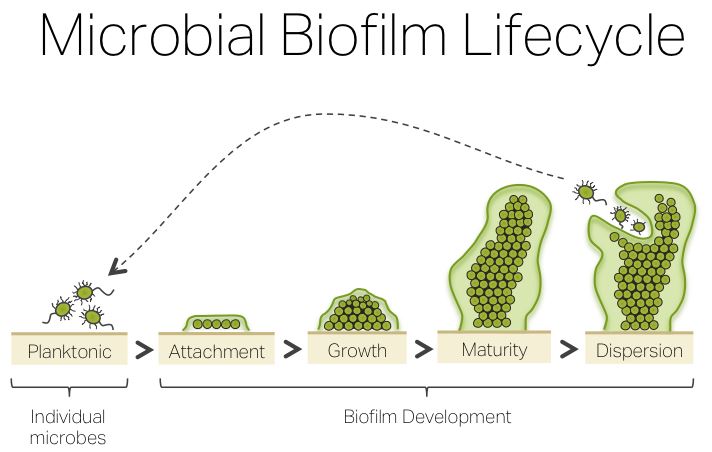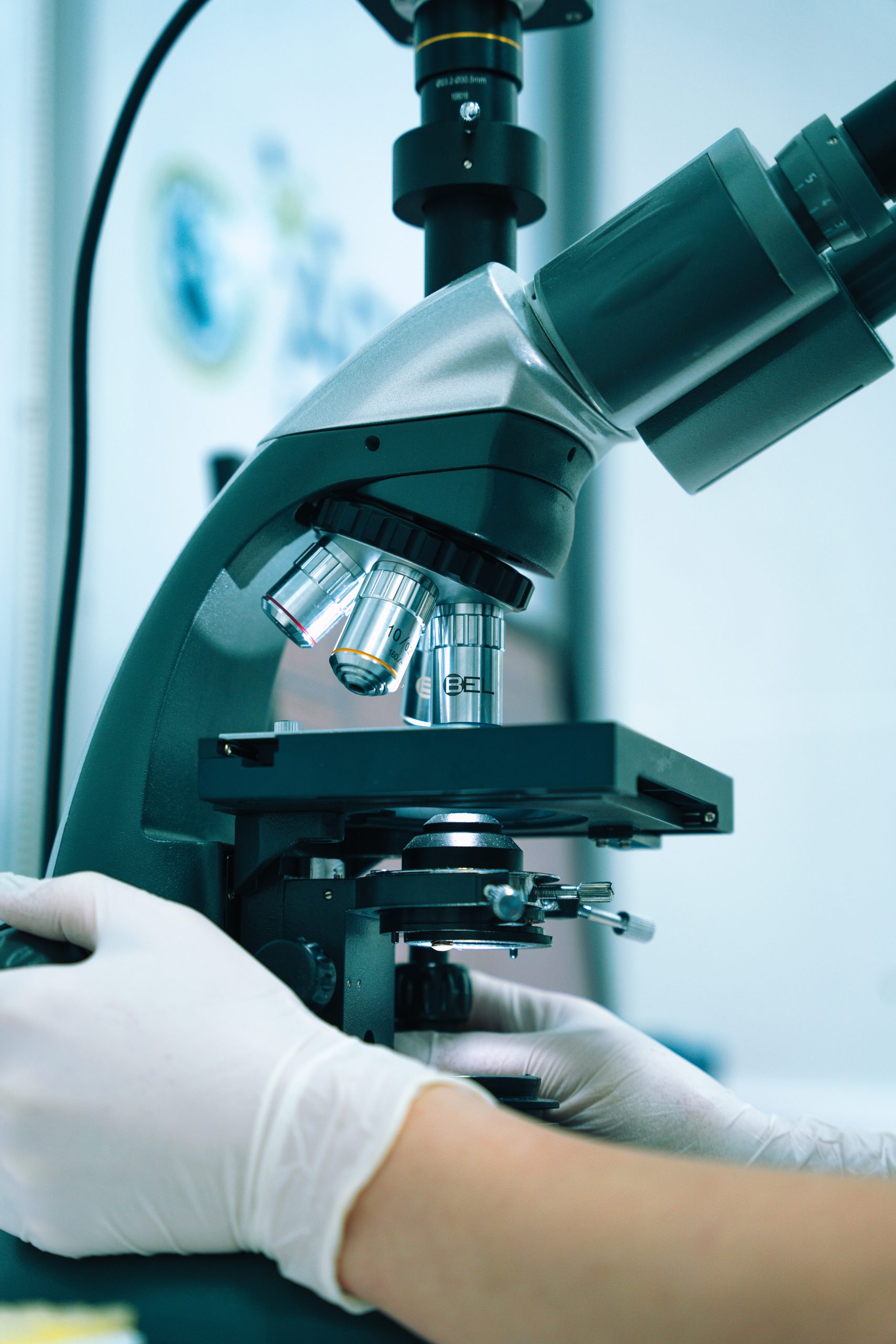Biofilms are bastions of BACTERIA
Biofilms are bastions of BACTERIA
Far from being harmless documentaries about someone’s life, biofilms are dangerous bacterial growth that causes a “film” over the surface that is hard to remove. Scientists have found that persistent infection problems in places such as hospitals, nursing homes, food processing plants and drinking water distribution systems is not due to free-floating “planktonic” bacteria. Over short periods of time (hours and days), complex surface-attached communities of bacteria form, held together by self-produced polymer matrices (long chains of organic molecules made by the bacteria themselves). (from Beyond Risk: Bacterial Biofilms and Their Regulating Approaches) These are called biofilms, and their persistence is very problematic to our health and quite a few industries.
Essentially, whenever you use a toothbrush or go to a dentist for teeth-cleaning, you are engaging in “biofilm control”. In fact this is how biofilms were first described–when the inventor of the microscope, Anton Von Leeuwenhoek, saw microbial aggregates on scrapings of plaque from his teeth. (Biofilms: A microbial home) Here are some more facts about them from this article:
- Biofilms form on virtually all surfaces immersed in natural aqueous environments.
- Bacteria in biofilms are 1000-1500 times more resistant to antibiotics than free-moving bacteria (also known as their planktonic state).
- Biofilms have been found to be involved in a wide variety of microbial infections (by one estimate 80% of all infections). Such infections include periodontal disease, musculoskeletal infections, osteomyelitis (bone infections), bacterial prostatitis, native valve endocarditis (inflammation of the heart’s lining and valves), cystic fibrosis pneumonia and GI infections, all of which can be persistent and chronic.
Although it can happen quickly and is microscopic, the growth of a biofilm happens in 5 distinct and complex steps. In a nutshell, these are (from Beyond Risk: Bacterial Biofilms and Their Regulating Approaches):
- reversible attachment, where bacteria attach to surfaces
- irreversible attachment, involving interaction between bacterial cells and a surface using bacterial adhesins
- extracellular polymeric substances (EPS) production (helps strengthen the film)
- maturation of biofilm (bacterial cells synthesize and release signaling molecules to sense the presence of each other)
- dispersal/detachment (cells release and go back to an independent lifestyle).
Source: bellalindemann.com
Why do bacteria form biofilms? It appears to be a survival strategy of “strength in numbers” to provide protection for bacteria and make them more suitable for the external environment under certain conditions. What’s good for them, is mostly bad for us. Biofilms are like fortified castles of infection.
Biofilms are the major mode of microbial growth, and the most challenging problem in drinking water system disinfection. Not only do biofilms contain life-threatening microbes, the way they coat the inside of pipes promotes corrosion, and reduces heat transfer.
The good news is that ancient, non-toxic materials like copper and silver are useful in sanitizing drinking-water systems. The first installation of a copper‑silver ionization system in the United States was in 1990, where a Pittsburgh, Pennsylvania hospital showed that Legionella colonization of distal outlets (those located farthest from the source) was reduced from 75% to 0% in 3 months. When the ionization unit was deliberately inactivated, recolonization of bacteria was delayed, and the water system remained free of Legionella for an additional 2–3 months; accumulation of ions inside the biofilm was demonstrated to be the basis for the prolonged bactericidal effect. Copper‑silver ionization has been used to control Legionella in hospitals worldwide. For example, ten cases of Legionnaires’ disease occurred at the University of Wisconsin hospital from 1985 to 1995, despite hyperchlorination. Following installation of copper‑silver ionization, Legionella was eliminated from the drinking water system and no cases were diagnosed.(Silver Ion-an overview)
Biofilms also occur on marine equipment like ships’ hulls and water-cooled heat exchangers. Organisms like algae, barnacles and mussels build up on underwater surfaces, called “biofouling”, and cause adverse effects of slower speed and increased fuel consumption on a ship’s hull and reduced heat transfer in heat exchangers. To combat biofouling, paint that contains copper is commonly applied to hulls, and new silicone coatings are being developed. (Paint and Coatings Industry magazine) For heat exchangers, slippery coatings are also a solution, as well as iodine bubble systems that can safely kill organisms and prevent them from attaching. This is particularly helpful in sensitive marine habitats and fish hatcheries (Hatchery International).
Bacteria may have developed biofilms for survival, but scientists have found ways to penetrate the films.
- Biofilms on teeth can be controlled by a variety of mechanisms. These are basically mechanical (remove with toothbrush, water pick, dental floss), or chemical (dissolve it with enzymes, antibiotics, alchohols and other rinses). (Biofilms: A microbial home) Regular maintenance to control biofilms is key to keeping that “coat” of slime from building up, but some of that bacteria could be protected us from more harmful microbes. Check out this short video if you want to see the colonies of plaque in your mouth!
- Silver nanoparticles can penetrate through the bacterial biofilms to completely destroy them and can even prevent microbes from developing biofilms. Silver nanoparticles can also be combined with antibiotics to increase the penetration power of the antibiotics. (The silver lining: towards the responsible and limited usage of silver)
- Iodine is another natural inhibitor to biofilm. Titanium implants treated with an iodine coating were shown to have significantly less biofilm growth of Staphylococcus bacteria than the control implants (study on rats). Iodine is a key ingredient in our TotalClean multi-surface, multi-purpose cleaner.
- Some scientists are developing microscopic spiky surfaces that actually inhibit attachment of biofilms. (statnews.com)
- Electrical microcurrents can also disrupt the bacterias’ ability to form biofilms. Arizona-based Vomaris Innovations markets a wound dressing called Procellera that generates microcurrents to aid in wound healing. (statnews.com)
- Because the bacteria within biofilms use a method of communication called quorum sensing, methods to interrupt this communication have shown to be successful in interrupting the establishment or continuity of the biofilm. Foods and food-based supplements such as turmeric (containing Curcumin), garlic (containing ajoene and allicin), apple cider vinegar, vanilla beans, oregano oil (containing carvacrol) pomegranate (containing ellagic acid), and cinnamon (to name but a few) have been scientifically proven to disrupt or prevent biofilm formation. (Natural Biofilm Disruptors That Work) Another list of quorum sensing inhibitors is found here.
If you have chronic symptoms in your body (like gut or sinus infections) or your home (like mold or odor) that just won’t let up, a biofilm could be the culprit, and there may be a non-toxic, non-drug solution out there to overcome it. Most often, a combination of natural therapies will be the best solution. Functional medicine doctors and mold specialists alike are familiar with biofilms and can guide you to better health. Also, polar ionizers like the Germ Defender, Air Angel and Whole Home Polar Ionizer act similarly to silver ions as the ions cling to the surface of bacteria and viruses and inhibit their ability to infect. With biofilms, it’s a matter of working smartly and intensely–don’t give up!
Photo by Akram Huseyn on Unsplash


